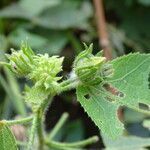A small annual shrub. It has bristles. It grows 2 m tall. It has chalky secretions near on the lower side of the leaf at the base. The leaves are 20 cm long by 15 cm wide. It is almost round but with lobes at the end. There are teeth around the edge. The flowers are yellow with a red base. They are 9 cm across. The fruit is a capsule 15 mm long by 10 mm wide. The seeds are 2.5 mm long by 2 mm wide.
Annual or perennial herb, up to 2 m high. Bracts of epicalyx threadlike, flexuous, not wider than 0.5 mm. Chalky incrustations present towards base of undersur-face of leaf lamina, deeply palmatilobed. Flowers yellow or yellowish orange with purplish or reddish centres.
Flowers c. 9 cm., in diam., yellow or yellowish-orange with purplish or reddish centres, solitary, axillary; peduncle up to c. 7 cm. long, hairy like the stems, articulated towards the apex.
Annual (or perennial?) herb up to 2 m. tall; stems setose-pilose with irritant hairs and densely pubescent to tomentellous.
Calyx 15–30 mm. long, pilose and pubescent; lobes up to 20 × 12 mm., ovate-elliptic, acute, joined at the base for 3–6 mm.
Seeds 2–2·5 × 1·8–2 mm., angular-subreniform, sparsely scaly or verruculose, often glabrescent.
Petals up to 5 × 3·5 cm., obovate, almost glabrous or with a few sparse dark hairs.
Staminal tube 15–18 mm. long; free parts of filaments 1–2 mm. long.
Flowers up to 4 in. diam., yellow, with a red base turning violet.
Epicalyx of 7–10 bracts; bracts 6–10 mm. long, filiform.
Capsule 15 × 10 mm., ovoid, setose-pilose.
Style-branches c. 1–5 mm. long.
A woody herb, to 6 ft. high
Spreading pungent hairs

